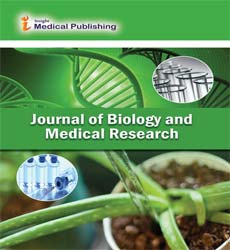Chromosomal Q-Heterochromatin in Norm and Pathology
Abyt Ibraimov*
Laboratory of Human Genetics, National Center of Cardiology and Internal Medicine, Kyrgyz Republic, Kyrgyzstan
- *Corresponding Author:
- Abyt Ibraimov
Laboratory of Human Genetics
National Center of Cardiology and Internal Medicine
Kyrgyz Republic, Kyrgyzstan
Tel: 996312-622761
E-mail: ibraimov_abyt@mail.ru
Received Date: November 03, 2017; Accepted Date: November 15, 2017; Published Date: November 20, 2017
Citation: Ibraimov A (2017) Chromosomal Q-Heterochromatin in Norm and Pathology. J Biol Med Res Vol.1 No.1: 7.
Abstract
The well-known human geneticist F. Vogel more than 20 years ago wrote: “Medicine is not a science; it provides rules for appropriate action. But such rules are derived from scientific knowledge. One hundred years ago, bacteriology was the leading basic science for medicine; human genetics has largely occupied this place in recent decades. In the future, molecular genetics and population genetics might become the most important scientific basis of medicine”
Editorial
The well-known human geneticist F. Vogel more than 20 years ago wrote: “Medicine is not a science; it provides rules for appropriate action. But such rules are derived from scientific knowledge. One hundred years ago, bacteriology was the leading basic science for medicine; human genetics has largely occupied this place in recent decades. In the future, molecular genetics and population genetics might become the most important scientific basis of medicine” [1,2].
All human populations today probably derive from an ancestral group living only about 100,000 – 150,000 years ago, rather than a million or more years ago. Even 12,000 years ago, the size of the human population was low, with a world population of only around 10 million. Now humans are by far the commonest primates; there are more than 7000 million of us. The human species can tolerate such a range because each of us carries a tropical microenvironment in the form of clothes and dwellings (tropicalization). Can all this be explained, for example, from the point of view of cytogenetics?
As the results of our many years of research show the study of the wide variability of chromosomal Q-heterochromatin regions (Q-HRs) can provide an answer to many questions that have not yet been rationally explained. By studying chromosomal Q-HRs variability in the human populations living in various climatic-and geographic conditions of Eurasia and Africa, in norm and pathology we have obtained the data indicating possible participation of Q-HRs in adaptation by regulating cellular thermoregulation [3-5]. The role of Q-HRs seems to be as follows: individuals with a smaller number of Q-HRs can work longer; at the same time, individuals with a larger amount of their chromosomal Q-HRs in genome under conditions of cold, having a high heat-loss capacity, rapidly lose heat from the organism [3,6-10].
Our published data on the distribution of the number of chromosomal Q-HRs in the genome of individuals with certain forms of purely human pathology (alcoholism, drug addiction, obesity and coronary heart disease) remains unclaimed [8-11]. However, we are confident that our observations will be confirmed if any investigators should wish to verify them. Moreover, we shall not be surprised if in the future it will be found that there exists a certain relation between the number of Q-HRs in the genome and the predisposition of man to common cold [8] and his aptitude for certain types of sport (e.g. mountaineering, professional boxing, marathon race, swimming, including that in pearl-divers) related to body thermoregulation. Our only fear is that our colleagues from developed countries would become like scientists of Europe from the story of a Saint-Exupery “The Little Prince” when they didn’t believe in the existence of an asteroid from which the little prince arrived just because there was a turban on the head of the Turkish scientist who announced this.
References
- Vogel F (1996) Human genetics and infectious diseases. Indian J Hum Genet 2: 77-86.
- Ibraimov ÃÂÂÂI, Mirrakhimov ÃÂÂœÃÂÂœ (1985) Q-band polymorphism in the autosomes and the Y chromosome in human populations. In: “Progress and topics in cytogenetics. The Y chromosome. Part ÃÂÂÂ. Basic characteristics of Y chromosome”. ÃÂÂÂÃÂÂÂ. Sandberg (Ed) Alan R. Liss, Inc., New York. USA pp: 213-287.
- Ibraimov ÃÂÂÂI (1993) The origin of modern humans: A cytogenetic model. ÃÂÂÂum Evol 8: 81-91.
- Ibraimov AI (2003) Condensed chromatin and cell thermoregulation. Complexus 1: 164-170.
- Ibraimov AI (2004) The origin of condensed chromatin, cell thermoregulation and multicellularity. Complexus 2: 23-34.
- Ibraimov AI (2015) Heterochromatin: The visible with many invisible effects. Glob J Med Res 15:7-32.
- Ibraimov AI (2016) Why only people and apes are ill with common cold? The possible role of chromosomal Q-heterochromatin. J Mol Biol Res 6: 11-19.
- Ibraimov AI (2016) Chromosomal Q-heterochromatin polymorphism in patients with alimentary obesity. Biol Med 8: 275.
- Ibraimov AI (2016) Chromosomal Q-heterochromatin regions in alcoholics and drug addicts. Biol Med 8:346.
- Ibraimov AI (2017) Cell thermoregulation: Problems, advances and perspectives. J Mol Biol Res 7: 58-79.
- Ibraimov AI (2017) Chromosomal Q-heterochromatin and atherosclerosis. J Mol Biol Res7: 1.
Open Access Journals
- Aquaculture & Veterinary Science
- Chemistry & Chemical Sciences
- Clinical Sciences
- Engineering
- General Science
- Genetics & Molecular Biology
- Health Care & Nursing
- Immunology & Microbiology
- Materials Science
- Mathematics & Physics
- Medical Sciences
- Neurology & Psychiatry
- Oncology & Cancer Science
- Pharmaceutical Sciences
